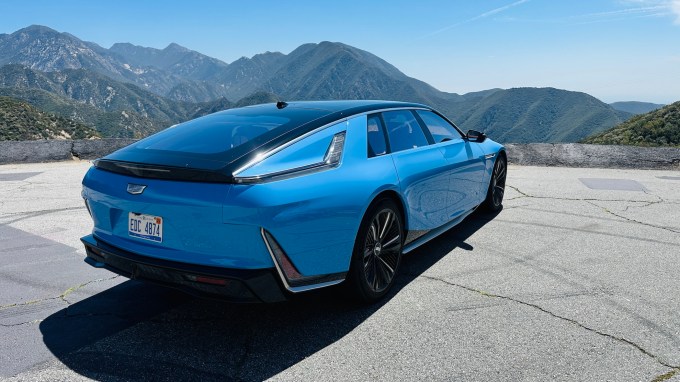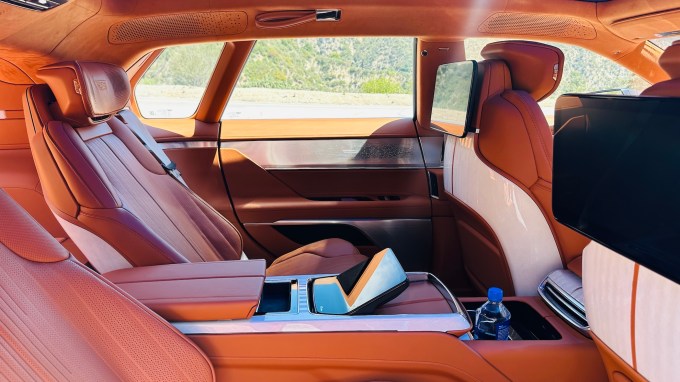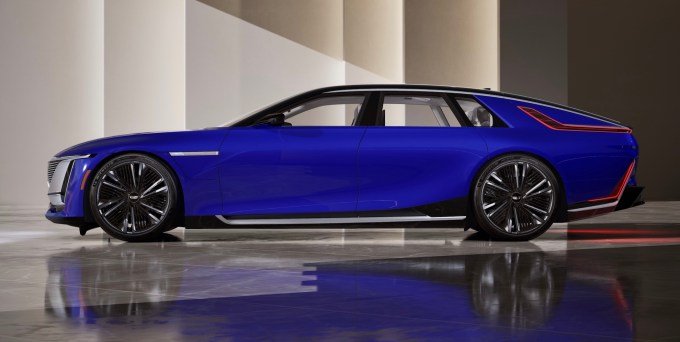Almost three years following the debut of the conceptual version of the top-tier Cadillac Celestiq EV, General Motors has at last presented the actual product: an opulent $360,000 electric car with a striking design meant to attract attention from everyone around.
However, is this custom electric vehicle sufficient for Cadillac? regain its position As the "Standard of the World"? I dedicated a day to maneuvering this giant through Los Angeles in an attempt to discover more.
Climbing into the driver's seat of the latest flagship fastback is an excellent beginning.
I'm enveloped by supple leather—the softness cradling my posterior from the plush, fully adjustable seat. It’s crafted with meticulous precision akin to a high-end Richard Mille timepiece; each component exudes an artisanal feel when touched. Despite this luxurious ambiance, over 115 components were produced using 3D printing technology, such as the central part of the steering wheel, window controls, sections of the console trim, and certain structural elements.
Clearly, Cadillac aimed to create an electric vehicle without any trade-offs. Nonetheless, the configuration of the battery pack posed specific design difficulties.
The components within the Cadillac Celestiq’s battery pack vary in size. In contrast to the Lyriq, which features a flat battery pack, the Celestiq incorporates modules of varying dimensions throughout its battery assembly—some being taller than others. Specifically, the modules beneath the front seats stand at approximately nine inches high, whereas those located underneath the back seat area measure just six inches tall. To elevate the rear seating position, additional modules measuring twelve inches tall are used.
Engineers had to position several modules beneath the center console to accommodate an 111 kWh battery offering a range of 303 miles. This led to the creation of a small storage space that can barely hold items as compact as a wallet and eyeglasses.
Cadillac Celestiq EV: The Driving Experience

The stares I got as I drove the Celestiq more than compensated for the tiny central console space. Nothing else on the streets compares in terms of elegance; its flowing design, complete with animated LED headlights at the front and a sleek tail end, makes it stand apart. Amid all the artificial allure around here, the genuine article—the Celestiq—really shines through.
I begin my journey through the tough streets of Hollywood, deliberately heading towards cracked pavements and manholes. The test vehicle comes equipped with 22-inch wheels — though 23-inch options are also available — along with Michelin Pilot Sport EV tires featuring minimal sidewalls.
Using a small rubber component between the car and the road typically leads to a rough journey. However, the Celestiq features a forgiving air suspension system that manages these issues effectively. While larger obstacles such as deep potholes can still be felt, urban driving remains tranquil and seamless.
Make no mistake, This car is a large one. The Cadillac Celestiq boasts a bigger size compared to a two-door Chevrolet Silverado, enhanced for agility with rear-wheel steering. While it might be challenging to squeeze into city street spots, this vehicle is better suited for the valet area.
After departing from Hollywood, I venture into the mountains to experience what 655 horsepower and 646 pound-feet of torque can achieve on winding roads. In this setting, the Magnetic Ride Control excels, swiftly adapting to both the road conditions and the vehicle’s shifting weights for a reassuring sense of command. Enhanced by active roll control, the car remains stable around corners regardless of its substantial size.
The steering feels somewhat unresponsive, yet it has a good heft to it and the brake regeneration offers a novel challenge to master. When set to maximum regen, timing my throttle releases correctly allows me to avoid using the physical brakes until entering a curve. Despite this, the car’s weight shifts forward providing enough traction for turning, all while accumulating extra electricity simultaneously.
I love it.
I crank up the Dolby Atmos sound system pouring out of 38 internal AKG speakers– there are four outside the car that produce cool EV sounds for those unlucky enough to be walking – and head out to the highway. Of course, GM’s Super Cruise advanced driver assistance system is here, so I take my hands off the wheel and let the car take over for a while in traffic.
The The Cadillac Celestiq EV is facing an issue.

The main issue with the Celestiq is simply that I struggle to consistently connect my phone for hands-free texting and calling. While I'm okay with all General Motors' electric cars using Google Built-In instead of Apple CarPlay and Android Auto, which work well—especially considering how Google Maps accurately estimates battery life upon arrival and suggests nearby charging points as necessary—it's frustrating that integrating my smartphone remains unreliable despite these benefits.
It’s not only present in the Celestiq; with both the Optiq and the Escalade IQ, this issue occurs as well. Several configurations on my iPhone must align perfectly for it to work properly. Occasionally, I need to reestablish the connection after turning off the vehicle, and occasionally, it simply fails to notify me about incoming texts.
Premium clients expect simplicity and user-friendliness. However, this smartphone integration system fails to meet those expectations.
The inside of the Cadillac Celestiq electric vehicle

However, at least the displays look fantastic.
Spanning the entire breadth of the dashboard, you get 55 inches of high-definition display. A separate screen is provided for the passenger to enjoy media playback and web surfing, with all climate settings controlled via a smaller touchscreen located beneath the dashboard.
I'd trade my entire kingdom for some tangible HVAC controls, but considering this vehicle, I'll accept having a dedicated display so I can avoid navigating through multiple menus just to activate the AC.
The massaging seats are present, as expected, and appear to remain activated for a slightly longer duration compared to those in other luxury cars I've experienced. One notable absence is the lack of heated and cooled cup holders; this seems akin to serving caviar without crème fraîche—a significant oversight in my opinion. However, Cadillac informed me that they can include this feature upon request should anyone desire it.
I love the glass roof that can adjust up to 20% opacity across any of the four sections. Every passenger in the car can personalize the amount of light they desire in their section of the vehicle.

I'm not entirely convinced about the power windows because I tend to imagine scenarios where they might fail when I least want them to—like getting trapped at Whole Foods' parking lot. However, pressing the brake pedal to make the window roll up automatically does seem pretty neat. Additionally, there’s an option on the touchscreen below that lets you close all the windows with ease; this way, your passengers can join in the experience of using advanced yet effortless technology.
Bespoke Cadillac EV experience

Every Celestiq will be crafted individually at General Motors' Global Technical Center in Michigan.
I had a preview of what customers can expect when I collaborated with a designer to pick my preferred hues and materials. With options that seemed like every shade imaginable—possibly up to fifty different tones for each element—it felt somewhat daunting. However, I left with my ideal Celestiq in Kingfisher Tricoat, a striking blue color that complements the elongated wheelbase and sleek fastback design beautifully. Inside, I chose a combination of Sheer Gray and Bahia Orange accented with Phantom Blue details. Let’s just say, I’m really into the blend of blue and orange.
Throughout the day, I enjoyed the Cadillac concierge service that clients encounter during their purchase journey. There was someone making certain I constantly had a chilled Diet Dr Pepper within reach, and the meal choices catered to my less sophisticated food preferences. To put it simply, I indulged in tater tots for lunch without feeling the slightest bit ashamed.
Although Celestiq buyers may rely on their personal concierge for handling logistical needs rather than asking for excessive quantities of carbohydrates and coffee, the essence remains that these clients will have an individual dedicated to fulfilling all their vehicle purchasing desires.
The high-end electric vehicle market doesn't have many players. The main competitor of the Cadillac Celestiq could likely be the Rolls-Royce Spectre EV due to its distinctive starlit roof feature. However, for the most part, the Celestiq remains largely unchallenged within the exclusive segment of all-electric super luxuries.
Bentley doesn’t have a full battery-electric offering yet, just hybrids and even Mercedes hasn’t fully electrified the Maybach S Class sedan, although you can get a Maybach EQS SUV.
If owning one is your dream, best of luck to you. Cadillac plans to manufacture just 25 units for the year 2025, and almost all have been reserved. As for 2026’s production, the firm hasn't disclosed exact figures but has mentioned that output will be restricted to a similar number. fewer than two Celestiqs a day .

Posting Komentar
Posting Komentar